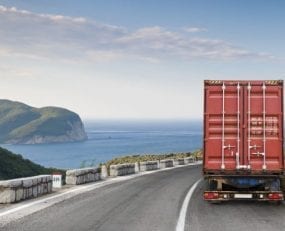
Recently DB Schenker and MAN teamed up to develop networked truck convoys and test their use in real life operations. In 2018, they plan to operate a truck platoon on the A9 motorway between Munich and Nuremberg and subsequently deploy self-driving trucks. Platooning field trials of this type are already occurring in Europe and the US.
Truck platooning refers to a system of two or more trucks driving very close behind the leading vehicle, with the next truck automatically following the leading vehicle through vehicle-to-vehicle (V2V) communication. In addition to V2V communication, trucks rely on radars and cameras, which inform the system and thus allow trucks to respond up to 25 times more quickly than a human-being, with the trucks able to slow down before our eyes could perceive that the vehicle in front is braking. The first truck, which is manually driven, determines the speed and direction.
Truck platooning is expected to improve different aspects of road freight transport and help meet several challenges that are currently faced by the road freight industry and society in general. Reduction of greenhouse emissions and road freight operational costs due to fuel savings as well increased road safety due to the elimination of human error and less road congestion, to name a few.
To capture the value and potential of the system it is worth considering it as an interim step to fully self-driving truck convoys. The successful implementation of trucks travelling semi-autonomously platoons could eventually lead to unlocking the potential of technology in taking over the task of piloting trucks.
Willing to bring the system one step closer to implementation, six brands of automated trucks tested the system on public roads from several European cities to the Netherlands in April 2016 as part of the European Truck Platooning Challenge. The test showed that it is already technically possible to platoon – with two or three trucks from the same brand – on public roads throughout Europe.
Driven by the desire to lead in convoy driving and the deployment of freight and other vehicles with a basic autonomous driving ability, Germany is earmarking €80m to subsidise promotion of convoy driving and the use of self-steering vehicles. This is to be seen as yet another attempt by the German government to facilitate an increase in the efficiency of logistics processes. Such is the case with the mega trucks rumoured to be nearing approval in this country.
According to some estimates, the market penetration of truck platooning is predicted to achieve 5.5% by 2025, growing to about 30% in 2035. Nonetheless, several obstacles need to be ironed out for these forecasts to materialise, the legal framework being one of the key hurdles. To see the system implemented regulations will need to keep up with the technology, especially as the automation of vehicles increases. In addition to this, standardising legislation across Europe is also essential to enable platoons across borders. EU-wide conformity is crucial given that the system provides benefits when trips are sufficiently long, which often includes border crossing.
If this brief has been of interest you might also like to download Ti’s European Road Freight Transport 2016 report. It includes profiles of 20 European countries, as well as the region’s largest road freight operators. In addition, included in the report are Ti’s unique market sizing and forecasts, broken down by domestic and international road freight, for each European country.
Source: Transport Intelligence, December 6th, 2016
Author: Violeta Keckarovska